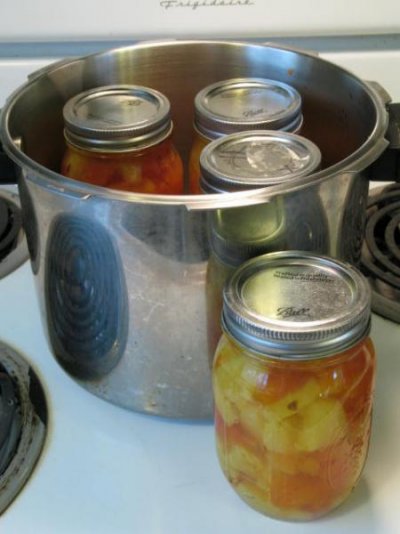Diana Walstad
Assistant Cook
I noticed that there was a flurry of reaction to my reusing canning lids on another thread ("peach canning"), so I started this new thread.
A lid -- whether reused or brand new -- either seals or it does not. If a reused lid seals and stays sealed, there's no reason for it to cause problems.
I am careful. [After canning, I remove the rings and carefully wash each jar, especially at the rim where the seal is. (Food crusted on the edge of the seal will attract bacteria, and their growth might break the seal. Also when I open the jars, I am careful not to dent the lid's metal. (That way, I can reuse the lids.)]
I started reusing lids when I was doing canning experiments for my book Cooking and Experimenting with Pressure Cookers. Since I was only doing experiments, I started reusing the lids. I must have used some lids 10 times. Now, I am reusing many of those same lids for canning fruit and meat stocks. No problem.
I just found confirmation for reusing canning lids here:
Reuse canning lids? - Page 2 - Survivalist Forum
I though this letter on the forum was pretty cool. (I had never thought of "plumping" up the sealing gums after they sagged.)
"My parents have reused lids for at least 35 years. When you reuse them, you have to boil them which "puffs" them back up and they have no or very little indent in them. My parents look at them after they have been boiled to determine whether or not they can be reused. If they are unable to be reused, they place a mark with a chine marker on them and use them only for sealing once they open to refrigerate the item or use them for storing dried foods."
Sorry for belaboring this point. However, I found that some of the advice provided by Ag Extension officials, USDA, etc does not make any sense. Reusing canning lids is one of them.
A lid -- whether reused or brand new -- either seals or it does not. If a reused lid seals and stays sealed, there's no reason for it to cause problems.
I am careful. [After canning, I remove the rings and carefully wash each jar, especially at the rim where the seal is. (Food crusted on the edge of the seal will attract bacteria, and their growth might break the seal. Also when I open the jars, I am careful not to dent the lid's metal. (That way, I can reuse the lids.)]
I started reusing lids when I was doing canning experiments for my book Cooking and Experimenting with Pressure Cookers. Since I was only doing experiments, I started reusing the lids. I must have used some lids 10 times. Now, I am reusing many of those same lids for canning fruit and meat stocks. No problem.
I just found confirmation for reusing canning lids here:
Reuse canning lids? - Page 2 - Survivalist Forum
I though this letter on the forum was pretty cool. (I had never thought of "plumping" up the sealing gums after they sagged.)
"My parents have reused lids for at least 35 years. When you reuse them, you have to boil them which "puffs" them back up and they have no or very little indent in them. My parents look at them after they have been boiled to determine whether or not they can be reused. If they are unable to be reused, they place a mark with a chine marker on them and use them only for sealing once they open to refrigerate the item or use them for storing dried foods."
Sorry for belaboring this point. However, I found that some of the advice provided by Ag Extension officials, USDA, etc does not make any sense. Reusing canning lids is one of them.


